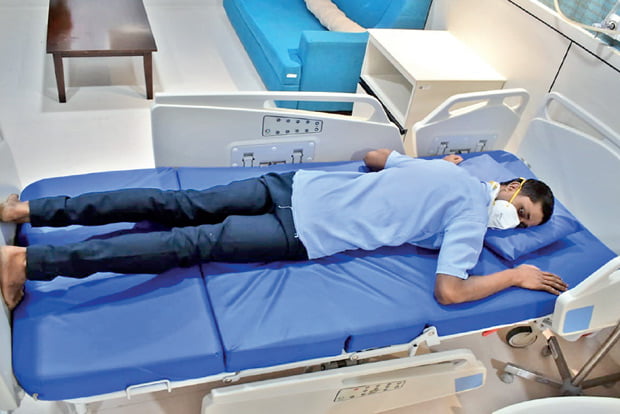Proning: Recommended By Health Ministry For COVID Treatment, Know Details

New Delhi: Amidst the nationwide shortage of oxygen in hospitals, COVID-19 patients who are being treated at home can practise proning if they are suffering from breathlessness.
The Union Health Ministry has released a detailed document explaining what proning is and how it helps in improving oxygenation. Doctors have advised self-monitoring of the oxygen level to understand whether there is a need for hospitalisation to decrease the pressure on hospitals.
In case, a patient feels discomfort in breathing, a symptom of the infection, they can lie face down, the guideline says.
What is proning?
Lying face down is known as proning, which is a medically accepted position to improve comfort and oxygenation, the health ministry said. If the oxygen level drops below 94, a patient in home isolation can lie on their belly as the position improves ventilation, keeps the alveolar units open.
What do you need for proning?
About four to five pillows — one to be placed below the neck, while one or two can be placed below the chest through upper thighs and two pillows can be placed below the shins.
One needs to change the lying position every 30 minutes from lying on the belly to lie on each side and then sitting up before going back to the first position of lying face down.
When not to do proning?
The ministry has listed four conditions when proning should be avoided.
- Pregnancy
- Deep venous thrombosis (treated in less than 48 hours)
- Major cardiac conditions
- Unstable spine, femur or pelvic fractures.
Other checklists to keep in mind while self-proning
- It should not be done for an hour after meals.
- Proning should be done when it feels tolerable.
- One may prone for up to 16 hours a day, in multiple cycles.
- Keep track of any pressure or injuries during proning.
Doctors at AIIMS, Patna have also released a Standard Operating Procedure (SOP) for COVID-19 patients, emphasised the use of prone positioning to manage blood oxygen levels.
News18 recently asked Dr Rajesh Pande, Senior Director of BLKC Center for Critical Care in Delhi the science behind it. Here is what he explained: “The lung has three regions, front, middle and back. When someone is lying with their back down-chest up, the blood supply to the back is the best, and the one to the front is the least. If you look at the air going in, the back gets the least oxygen supply. To change this, when someone is put in the prone position, the heart rests on the breast bone and gives space to the lungs to expand, increasing the airflow to the back, where the blood circulation is the most. So, coupled with better blood circulation, and more oxygen, then it leads to better, effective oxygenation.”

Comments are closed.